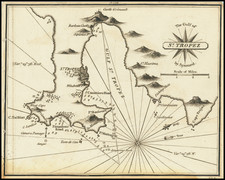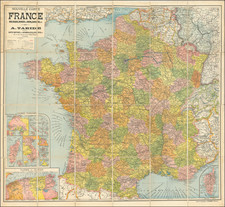Detailed map of Belle Isle, illustrating the battle fought in April 1761, from Heiden's Americanische urquelle derer innerlichen kriege des bedrängten Teutschlands.
Belle Isle was viewed by the British as a strategic stronghold for the French duirng the war. For the campaigns of 1761 against the island, Commodore Augustus Keppel was appointed to command the sea, and Major-General Studholm Hodgson the land forces. The latter had been one of Cumberland's numerous aides-de-camp both at Fontenoy and Culloden, and was a thorough Duke's man. In the present war he had commanded the first brigade at Rochefort, and been one of the famous council of war which, as Wolfe put it, decided unanimously "not to attack the place they were ordered to attack, and for reasons that no soldier will allow to be sufficient."
In March 1761, Admiral Augustus Keppel and the HMS Valiant let a squadron to reduce Belle Isle. The squadron at first included 10 sail of the line, 8 frigates, 3 sloops, 3 bombs, and 2 fireships, but was eventually reinforced with 5 more sail of the line. After an intitial landing on April 7, 1761, the British systematically pushed back the outnumbered French Forces.
Hodgson quickly overran the island as the French retreated and seized all the defenseless ports. He was then obliged to lie idle for 15 days, being unable to land his heavy artillery owing to continual gales. As soon as the weather permitted the necessary stores and material were landed. Hodgson commenced a seight of Palais, securely covered by Keppel's fleet. On May 2, batteries were erected against the town of Le Palais and in the preliminary operations before the place, some marines, under captain David Hepburn, greatly distinguished themselves.
During the next week, 2 more ships of the line joined Keppel, and he thereupon sent away to Ushant 5 to bring Buckle's blockading force superior to that which was said to be in Brest. Though only a captain, Keppel now had some 20 ships of the line and as many cruisers under his broad pendant, so that, with 8 left for himself, he was able to enjoy the disposition he wanted.With the arrival of the additional ships, detachments of several regiments of foot (about 3,000 men) gradually reinforced Hodgson's force.
On May 13, several advanced redoubts were carried by storm and the French were driven from Le Palais to the citadel.From May 16, the citadel of Palais was subjected to a furious bombardment.On June 7, a large breach had been formed in the walls of the citadel of Palais and preparations were being made for storming it. The chevalier de St. Croix, governor of the place, offered to surrender after a most gallant defence. On June 8, the British took possession of Le Palais. Sainte-Croix was allowed, as he richly deserved, to march out through the breach with all the honours of war, and was conveyed to Lorient with all that was left of his force.
Thus Belle-Isle was secured as a safe point for the British fleet while engaged in the work of blockading the French coast. The island was held during the remainder of the war.









![[France]. Das Gantz Franckreich so voz zeiten Gallia Narbonensis, Lugaunensis, Belgica und Celtica. . .](https://storage.googleapis.com/raremaps/img/small/83119.jpg)

![(France, Belgium, and Holland) Tabula Moderna Francie [Modern Map of France]](https://storage.googleapis.com/raremaps/img/small/101885.jpg)
![[Napoleon's Battles in France, Belgium Netherlands, Luxembourg, Germany] No. 1 Frontiere du Nord. Mesny 5.](https://storage.googleapis.com/raremaps/img/small/60727.jpg)

